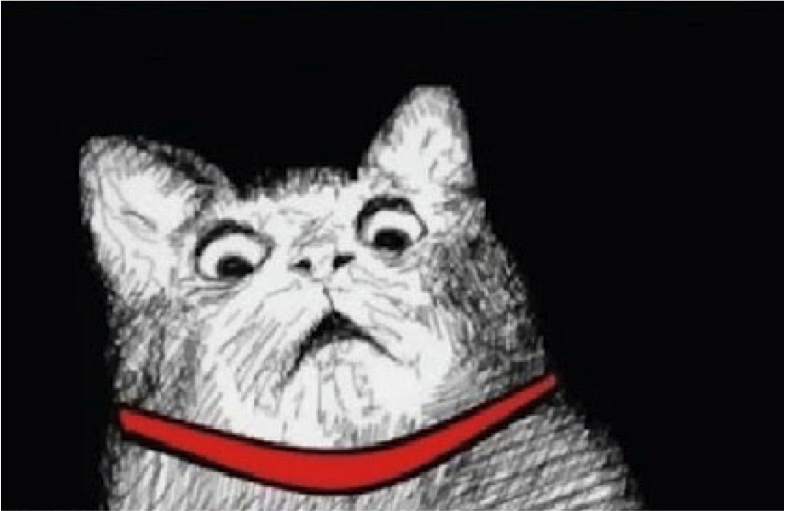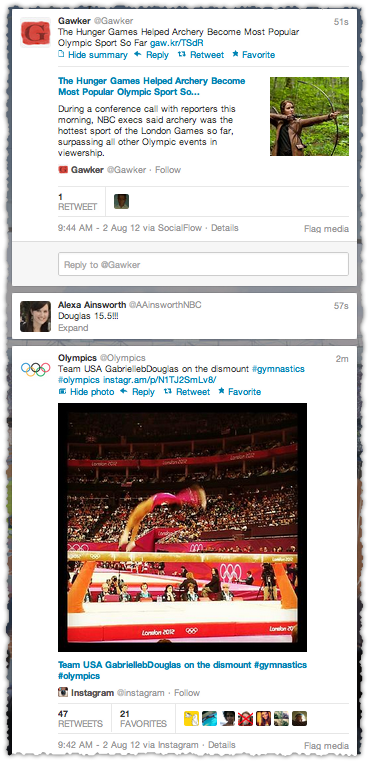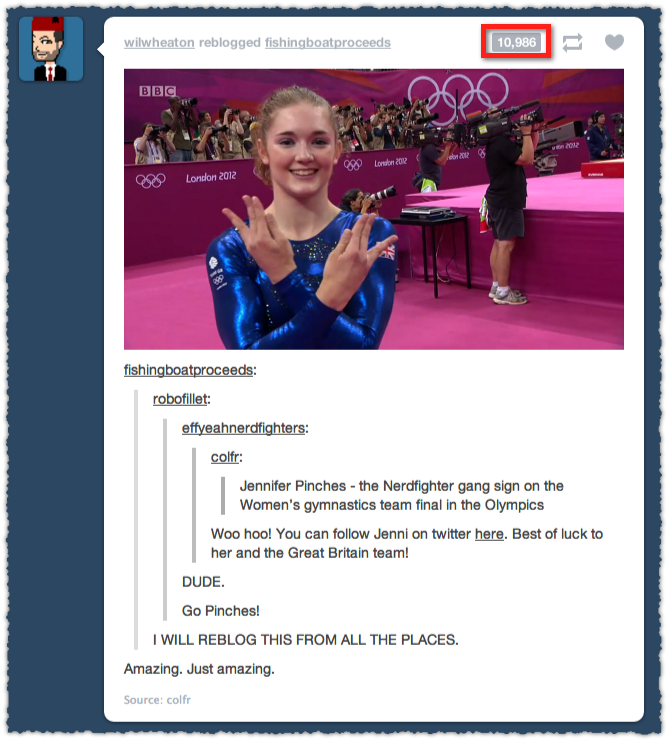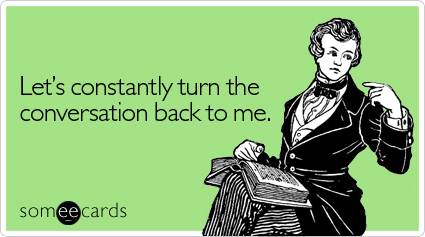Twitter is changing and a lot of people don’t like it. Developers are howling at being cut out and users are concerned about change. But the fact of the matter is that for Twitter to flourish it’ll need to evolve. Twitter needs to become Twumblr.
The Internet Is Visual

Remember, Twitter was established before the launch of the iPhone or Chrome. Yeah, think about that. Twitter has been around for over six years with a virtually unchanged UX. During that time the Internet has changed dramatically. It’s become vastly more visual in nature.
Many argue Facebook built their business on pictures. Look at the popularity of Flipboard, Pinterest and Instagram. Not to mention the incredible power of memes.
Twitter Cards
In light of this trend, Twitter recently introduced Twitter Cards, new structured mark-up that essentially creates rich snippets for Tweets. (Here’s how you can implement them.)
What this does is transform Twitter from a text based medium to a visual medium. Right now the default for Twitter Cards is closed, but what would happen if the default was set to open?

Suddenly Twitter looks a whole lot more like Tumblr, doesn’t it? And that’s not a bad thing as far as I’m concerned. Nor does it seem like a bad idea to Twitter.
As for the platform itself, Costolo said Twitter is heading in a direction where its 140-character messages are not so much the main attraction but rather the caption to other forms of content.
That’s a really interesting insight from Twitter’s CEO. I’m not sure you could make it any more clear than that.
Advertising Demands Attention
The reason this is all so important is that advertising demands attention. Twitter simply doesn’t have enough of it right now. People don’t sit on or browse Twitter. Instead, Twitter functions like the digital version of those black electricity power lines that cut across our landscape, ferrying people to interesting content where it is then monetized.
You’d think being a utility of sorts would be a good place to be, but it requires charging for the delivery of that content. The problem is, Twitter doesn’t own the power plants (content) nor limits who uses their service. All they really own are those wires and that’s important but ultimately … a commodity.
Twitter realizes that they need to be a destination. They need attention and eyeballs so they can monetize that content. They don’t want you reading Tweets on LinkedIn or in a third-party application. They want you to read them where they can advertise against them.
There have been many arguments recently about whether Twitter is looking to usurp those publishers. That there’s a tension there that will ultimately cause a rift. There might be, but perhaps not if Twitter can pull this off (which is not altogether clear.)
Twitter Wants to Monetize Sets of Content
If we think about Twitter less as an Internet megaphone and more as a curation service, you begin to see how it benefits users, Twitter and publishers.
Your stream becomes a highly curated set of content. It’s that set of content that Twitter seeks to monetize, not each individual piece. It is then up to individual content creators to ensure their content is optimized for that environment. That means good titles and great visuals to take advantage of scanning behavior.
Of course Twitter will allow advertisers to promote content into that steam, but it is all on the premise that the set of content displayed is valuable and secures attention.
Frictionless Engagement
Instead, I’m far more interested in how this impacts engagement. Because Tumblr is on to something.

They’ve reduced the friction of engagement by asking users to perform only one of two actions: reblog or like. And if you scroll back up and look at those open Twitter Cards you’ll note that the same metrics are displayed: retweets and favorites. That’s not a coincidence in my opinion.
The huge numbers on Tumblr are not an aberration either. There is a very connected and engaged audience there. Marketers should be falling over themselves to get their brands in front of these people.
This is also the reason I’m not convinced that limiting third-party development is some sort of death knell. It’s always hard to put the horse back in the barn, but you can have a decent developer ecosystem that builds value into your platform, not outside of it.
Conversation Killer?

The question for me is about conversation and comments. Tumblr is frustrating in this regard. Yet maybe that’s by design. Sure, you can integrate DISQUS into Tumblr but it’s certainly not the out-of-the-box default. Deeper engagement is found on the publisher site or other social networks.
The question to me is whether publishers want to own the conversation. Do they want users to comment and converse on their site? Many seem to think comments are more trouble than they’re worth but I have to believe that being the place where conversation is happening is good for business, if only for the extra page views.
That’s where Twitter has a problem. Because many use Twitter like a public instant messaging platform. The problem? It’s far from instant. You wind up having these clipped asynchronous conversations that feel like deep space time delay communication.
And the 140 character limit doesn’t even work to provide any type of real dialog. Other platforms like Google+ are far better at fostering strong conversations.
So, does Twitter want to try to hijack those conversations and foster deeper engagement on Twitter proper? To me, that’s the greater threat to publishers. Sure, Twitter wants to be a destination but not the destination.
TL;DR
Twitter needs to embrace radical change and evolve to stay relevant. The future of Twitter is one in which they monetize a visual set of ever changing curated content that captures attention but not conversation.
The Next Post: Readability and SEO
The Previous Post: Ripples Bookmarklet

6 trackbacks/pingbacks
Comments About The Future of Twitter is Twumblr
// 13 comments so far.
Brian Crouch // August 02nd 2012
“You wind up having these clipped asynchronous conversations that feel like deep space time delay communication.”
Idea: Sub-space Twitter. Might include a large silver earpiece Uhura-style.
AJ Kohn // August 02nd 2012
I swear Brian, that’s what it feels like now. “Captain, there’s an incoming sub-space signal.”
Alessio // August 03rd 2012
I love twitter because it’s simple. I understand they have to change, but I really hope they are not going to mess the simplicity up in order to become like Facebook or similar.
I’m not worried about change, but I hope they’re gonna change always keeping in mind simplicity.
AJ Kohn // August 03rd 2012
That’s the thing Alessio, I actually think that Twitter could be made more simple.
When I look at Tumblr, I think the way content moves through that platform does so both faster and wider. I think Twitter could be a powerful curation engine, a mashup of personal blogging and RSS aggregation. But they’ll have to leave some of their users behind who use it as a type of public SMS.
Danny Brown // August 03rd 2012
Interesting thoughts, AJ. When the purchase of Posterous happened, this was the exact line of thought I could see taking place. It makes sense to drop Posterous, take their talent pool, build on the Extended Tweets option (monetized service) and become a true, real-time blog.
Fun times ahead!
AJ Kohn // August 03rd 2012
Thank you for your comment and Tweet Danny.
Yes, I didn’t mention Posterous but I should have because clearly they had a similar vision to Tumblr. It’s been 4 months since and I think we’re starting to see how that acquisition could shape the future of Twitter.
The question really is whether users will accept the pivot from update service to real-time blog?
John Crenshaw // August 03rd 2012
“All they really own are those wires and that’s important but ultimately … a commodity.”
Awesome insight and it’s a good thing Twitter is moving in that direction. The last thing you want to be is a commodity if you can help it at all.
Personally, though, I think the images look exactly like G+.
AJ Kohn // August 07th 2012
John,
Thanks for the heads up to rescue your comment from spam. And I agree, the images do look very similar to Google+. Between Tumblr and Google+ (and a host of others) I think it’s clear to Twitter that they can’t just be text based anymore.
SEOGenX // August 03rd 2012
That’s what I was looking for. So, be ready Google+ and Facebook, twitter is coming..
Gaz Copeland // August 05th 2012
It’d be really great if they changed into a reliable platform. The amount of downtime/bugs people accept with Twitter is amazing to me, something goes wrong on FB people freak out, they seem to just accept it from Twitter.
AJ Kohn // August 05th 2012
Gaz,
Yes, they’ve gotten better but they still have downtime issues that can’t be ignored. Interestingly, Twitter probably wouldn’t have as many issues (and wouldn’t held to such a high standard) if it weren’t being used as a type of real-time news wire and instead moved toward content curation and micro-blogging.
Cogito Ergo Sum // August 15th 2012
Cool post!
imho tumblr (or even twitter.COM) are “content confederations” because like socialism, they endow a very specific mode of thinking within the same mindset.
Laura // August 25th 2012
If Twitter adds images it just merges with the pack. The only thing different about Twiter now is that it is text based which makes it light reading, quick and simple for posting and fast to load. Images will just cause bloat and how will Twitter be any different from Pinterest, Tumblr, etc? If they all become clones there will be no need to join more than one of them. Which may be a good thing. I’ve already dumped Facedbook and I’d never use LinkedIn again.
Sorry, comments for this entry are closed at this time.
You can follow any responses to this entry via its RSS comments feed.